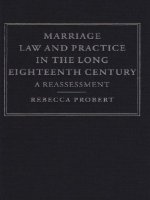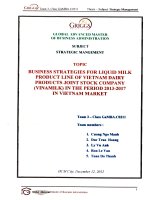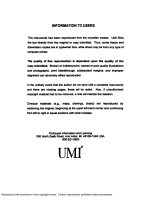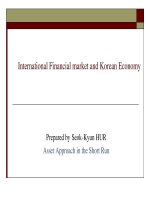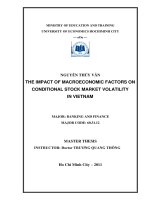Stock market returns in the long run
Bạn đang xem bản rút gọn của tài liệu. Xem và tải ngay bản đầy đủ của tài liệu tại đây (571.91 KB, 30 trang )
Yale ICF Working Paper No. 00-44
March 2002
STOCK MARKET RETURNS IN THE LONG RUN:
PARTICIPATING IN THE REAL ECONOMY
Roger G. Ibbotson
Yale School of Management
Peng Chen
Ibbotson Associates, Inc.
This paper can be downloaded without charge from the
Social Science Research Network Electronic Paper Collection:
/>
Stock Market Returns in the Long Run:
Participating in the Real Economy
Roger G. Ibbotson, Ph.D.
Professor in the Practice of Finance
Yale School of Management
135 Prospect Street
New Haven, CT 06520-8200
Phone: (203) 432-6021
Fax: (203) 432-6970
Chairman
Ibbotson Associates, Inc.
225 N. Michigan Ave. Suite 700
Chicago, IL 60601-7676
Phone: (312) 616-1620
Fax: (312) 616-0404
Peng Chen, Ph.D., CFA
Vice President, Director of Research
Ibbotson Associates, Inc.
225 N. Michigan Ave. Suite 700
Chicago, IL 60601-7676
Phone: (312) 616-1620
Fax: (312) 616-0404
E-mail:
March 2002
Stock Market Returns in the Long Run
ABSTRACT
We estimate the forward-looking long-term equity risk by extrapolating the way it participated in the real
economy. We decompose the 1926-2000 historical equity returns into supply factors including inflation,
earnings, dividends, price to earnings ratio, dividend payout ratio, book value, return on equity, and GDP
per capita. There are several key findings: First, the growth in corporate productivity measured by
earnings is in line with the growth of overall economic productivity. Second, P/E increases account for
only a small portion of the total return of equity (1.25% of the total 10.70%). The bulk of the return is
attributable to dividend payments and nominal earnings growth (including inflation and real earnings
growth). Third, the increase in factor share of equity relative to the overall economy can be more than
fully attributed to the increase in the P/E ratio. Fourth, there is a secular decline in the dividend yield and
payout ratio, rendering dividend growth alone a poor measure of corporate profitability and future growth.
Contrary to several recent studies, our supply side model forecast of the equity risk premium is only
slightly lower than the pure historical return estimate. The long-term equity risk premium (relative to the
long-term government bond yield) is estimated to be about 6% arithmetically, and 4% geometrically. Our
estimate is in line with both the historical supply measures of the public corporations (i.e., earnings) and
the overall economic productivity (GDP per capita).
1
Stock Market Returns in the Long Run
I. INTRODUCTION
Numerous authors are directing their efforts toward estimating expected returns on stocks incremental to
bonds.1 These equity risk premium studies can be categorized into four groups based on the approaches
they have taken. The first group of studies try to derive the equity risk premiums from historical returns
between stocks and bonds as was done in Ibbotson and Sinquefield (1976a,b). The second group, which
includes our current paper, uses fundamental information such as earnings, dividends, or overall
economic productivity to measure the expected equity risk premium. The third group adopts demand side
models that derive expected equity returns through the payoff demanded by investors for bearing the risk
of equity investments, as in the Ibbotson, Siegel, and Diermeier (1984) demand framework, and
especially in the large body of literature following the seminal work of Mehra and Prescott (1985). The
fourth group relies on opinions of investors and financial professionals through broad surveys.
Our paper uses supply side models. We first used this type of model in Diermeier, Ibbotson, and Siegel
(1984). There have been numerous other authors who have also used supply side models, usually focusing
on the Gordon (1962) constant dividend growth model. For example, Siegel (1999) predicts that the
equity risk premium will shrink in the future due to low current dividend yields and high equity
valuations. Fama and French (2002) use a longer time period (1872 to 1999) to get geometric equity risk
premiums of 2.55% using dividend growth rates, and 4.32% using earnings growth rates.2 Campbell and
Shiller (2001) argue for low returns, because they believe the current market is overvalued. Arnott and
Ryan (2001) argue that the forward-looking equity risk premium is actually negative. This stems from
using the low current dividend yield plus their very low forecast dividend growth. We later argue that
mixing the current low dividend yields and payout ratios with historical dividend yield growth violates
Miller and Modigliani (1961) dividend theory.
The survey results generally support somewhat higher equity risk premiums. For example, Welch (2000)
conducted a survey among 226 academic financial economics on equity risk premium expectations. The
2
Stock Market Returns in the Long Run
survey shows that the geometric long horizon equity risk premium forecast is almost 4%.3 Graham and
Harvey (2001) conducted a multi-year survey of CFOs of U.S. corporations, they find that the expected
10-year geometric average equity risk premium ranges from 3.9% to 4.7%.
In this paper, we link historical equity returns with factors commonly used to describe the aggregate
equity market and overall economic productivity. Unlike some studies, our results are portrayed on a per
share basis (per capita in the case of GDP). The factors include inflation, earnings per share, dividends per
share, price to earnings ratio, dividend payout ratio, book value per share, return on equity, and GDP per
capita.4 We first decompose the historical equity returns into different sets of components based on six
different methods. Then, we examine each of the components within the six methods. Finally, we
forecast the equity risk premium through supply side models using historical data.
Our long-term forecasts are consistent with the historical supply of U.S. capital market earnings and GDP
per capita growth over the period 1926-2000. In an important distinction from the forecasts of many
others, our forecasts assume market efficiency and a constant equity risk premium.5 Thus the current high
P/E ratio represents the market’s forecast of higher earnings growth rates. Furthermore, our forecasts are
consistent with Miller and Modigliani (1961) theory so that dividend payout ratios do not affect P/E ratios
and high earnings retention rates (usually associated with low yields) imply higher per share future
growth. To the extent that corporate cash is not used for reinvestment, it is assumed to be used to
repurchase a company’s own shares or perhaps more frequently to purchase other companies’ shares.
Finally, our forecasts treat inflation as a pass-through, so that the entire analysis can be done in real terms.
II. THE SIX METHODS FOR DECOMPOSING HISTORICAL EQUITY RETURNS
We present six different methods of decomposing historical equity returns. The first two methods
(especially method 1) are models based entirely on historical returns. The other four methods are models
3
Stock Market Returns in the Long Run
of the supply side. We evaluated each method and its components by applying historical data from 1926
to 2000. The historical equity return and earnings data used in this study are obtained from Wilson and
Jones (2002).6 The average compounded annual return for stock market over the period 1926-2000 is
10.70%. The arithmetic annual average return is 12.56% and the standard deviation is 19.67%. In as much
as our methods use geometric averages, we focus on components of the geometric return (10.70%). Later
in the paper when we do our forecasts, we convert geometric average returns to arithmetic average
returns.
Method 1 – Building Blocks Method
Ibbotson and Sinquefield (1976a,b) develop a building blocks method to explain equity returns. The three
building blocks are inflation, real risk-free rate, and equity risk premium. Inflation is represented by the
changes in the Consumer Price Index (CPI). The equity risk premium and the real risk-free rate for year t,
ERPt and RRf t , are given by
ERPt =
1 + Rt
R − Rf t
−1 = t
1 + Rf t
1 + Rf t
(1)
RRf t =
1 + Rf t
Rf − CPI t
−1 = t
1 + CPI t
1 + CPI t
(2)
Rt = (1 + CPI t ) × (1 + RRf t ) × (1 + ERPt ) − 1
(3)
Rt is the return of U.S. stock market represented by the S&P 500 index. Rf t is the return of risk-free
assets represented by the income return of long-term U.S. government bonds. The compounded average
for equity return is 10.70% from 1926-2000. For the equity risk premium, we can interpret that investors
4
Stock Market Returns in the Long Run
were compensated 5.24% per year for investing in common stocks rather than long-term risk-free assets
like the long-term US government bonds.7 This also shows that roughly half of the total historical equity
return has come from the equity risk premium, and the other half is from inflation and long-term real riskfree rate. The average U.S. equity returns from 1926 and 2000 can be reconstructed as follows:
R = (1 + CPI ) × (1 + RRf ) × (1 + ERP) − 1
(4)
10.70% = (1 + 3.08%) × (1 + 2.05%) × (1 + 5.24%) − 1
Method 2 – Capital Gain and Income Method
The equity return can be broken into capital gain ( cg ) and income return ( Inc ) based on the form in
which the return is distributed. Income return of common stock is distributed to investors through
dividends, while capital gain is distributed through price appreciation. Real capital gain ( Rcg ) can be
computed by subtracting inflation from capital gain. The equity return in period t can then be decomposed
as follows:
Rt = [(1 + CPI t ) × (1 + Rcg t ) − 1] + Inct + Rinvt
(5)
The average income return is calculated to be 4.28%, the average capital gain is 6.19%, and the average
real capital gain is 3.02%. Rinv , the re-investment return, averages 0.20% from 1926 to 2000. The
average U.S. equity return from 1926 to 2000 can be computed according to
[
]
R = (1 + CPI ) × (1 + Rcg ) − 1 + Inc + Rinv
10.70% = [(1 + 3.08%) × (1 + 3.02%) − 1] + 4.28% + 0.20%
5
(6)
Stock Market Returns in the Long Run
Figure 1 shows the decomposition of the building blocks method and the capital gain and income method
from 1926 to 2000.
Method 3 – Earnings Model
The real capital gain portion of the return in the capital gain and income method can be broken into
growth in real earnings per share ( g REPS ) and growth in the price to earnings ratio ( g P / E ),
Rcg t =
Pt
P /E
E
− 1 = t t × t − 1 = (1 + g P / E ,t ) × (1 + g REPS ,t ) − 1
Pt −1
Pt −1 / Et −1 Et −1
(7)
Therefore, the equity’s total return can be broken into four components: inflation; the growth in real
earnings per share; the growth in the price to earnings ratio; and income return.
Rt = [(1 + CPI t ) × (1 + g REPS ,t ) × (1 + g P / E ,t ) − 1] + Inct + Rinvt
(8)
The real earnings of US equity increased 1.75% annually from 1926. The P/E ratio was 10.22 at the
beginning of 1926. It grew to 25.96 at the end of 2000. The highest P/E (136.50) was recorded during the
depression in 1932 when earnings were near zero, while the lowest (7.26) was recorded in 1979. The
average year-end P/E ratio is 13.76.8 Figure 2 shows the price to earnings ratio from 1926 to 2000. The
U.S. equity returns from 1926 and 2000 can be computed according to
[
]
R = (1 + CPI ) × (1 + g REPS ) × (1 + g P / E ) − 1 + Inc + Rinv
10.70% = [(1 + 3.08%) × (1 + 1.75%) × (1 + 1.25%) − 1] + 4.28% + 0.20%
(9)
Method 4 – Dividends Model
Dividend ( Div ) equals the earnings times the dividend payout ratio ( PO ); therefore, the growth rate of
earnings can be calculated by the difference between the growth rate of dividend and the growth rate of
the payout ratio.
6
Stock Market Returns in the Long Run
EPS t =
Divt
POt
(1 + g REPS ,t ) =
(10)
(1 + g RDiv ,t )
(11)
(1 + g PO ,t )
We substitute dividend growth and payout ratio growth for the earnings growth in equation 8. The
equity’s total return in period t can be broken into five components: 1) inflation; 2) the growth rate of the
price earnings ratio; 3) the growth rate of the dollar amount of dividend after inflation; 4) the growth rate
of the payout ratio; and 5) the dividend yield.
(1 + g RDiv ,t )
− 1 + Inct + Rinvt
Rt = (1 + CPI t ) × (1 + g P / E ,t ) ×
(1 + g PO ,t )
(12)
Figure 3 shows the annual income return (dividend yield) of U.S. equity from 1926 to 2000. The dividend
yield dropped from 5.15% at the beginning of 1926 to only 1.10% at the end of 2000. Figure 4 shows the
year-end dividend payout ratio from 1926 to 2000. On average, the dollar amount of dividends grew
1.23% after inflation per year, while the dividend payout ratio decreased 0.51% per year. The dividend
payout ratio was 46.68% at the beginning of 1926. It decreases to 31.78% at the end of 2000. The highest
dividend payout ratio (929.12%) was recorded in 1932, while the lowest was recorded in 2000. The U.S.
equity returns from 1926 and 2000 can be computed according to
(1 + g RDiv )
R = (1 + CPI ) × (1 + g P / E ) ×
− 1 + Inc + Rinv
(1 + g PO )
1 + 1.23%
10.70% = (1 + 3.08%) × (1 + 1.2 5%) ×
− 1 + 4.28% + 0.20%
1 − 0.51%
(13)
Method 5 – Return on Book Equity Model
7
Stock Market Returns in the Long Run
We can also break the earnings into book value of equity (BV) and return on equity (ROE).
EPS t = BVt × ROEt
(14)
The growth rate of earnings can be calculated by the combined growth rate of BV and ROE.
(1 + g REPS ,t ) = (1 + g RBV ,t )(1 + g ROE ,t )
(15)
We substitute BV growth and ROE growth for the earnings growth in the equity return decomposition.
The equity’s total return in period t can be computed by,
Rt = [(1 + CPI t ) × (1 + g P / E ,t ) × (1 + g RBV ,t ) × (1 + g ROE ,t ) − 1] + Inct + Rinvt
(16)
We estimate that the average growth rate of the book value after inflation is 1.46% from 1926 to 2000.9
The average ROE growth per year is calculated to be 0.31% during the same time period.
[
]
R = (1 + CPI ) × (1 + g P / E ) × (1 + g BV ) × (1 + g ROE ) − 1 + Inc + Rinv
10.70% = [(1 + 3.08%) × (1 + 1.2 5%) × (1 + 1.46%) × (1 + 0.31%) − 1] + 4.28% + 0.20%
(17)
Method 6 - GDP Per Capita Model
Diermeier, Ibbotson, and Siegel (1984) proposed a framework to analyze the aggregate supply of
financial asset returns. Since we are only interested in the supply model of the equity returns in this study,
we developed a slightly different supply method based on the growth of the economic productivity. This
method can be expressed by the following equation:
Rt = [(1 + CPI t ) × (1 + Rg GDP / POP ,t ) × (1 + g FS ,t ) − 1] + Inct + Rinvt
(18)
The return of the equity market over the long run can be decomposed into four components: 1) inflation;
2) real growth rate of the overall economic productivity (the GDP per capita ( g GDP / POP )); 3) the increase
8
Stock Market Returns in the Long Run
of the equity market relative to the overall economic productivity (increase in the factor share of equities
in the overall economy ( g FS )); and 4) dividend yields. Instead of assuming a constant factor share, we
examine the historical growth rate of factor share relative to the overall growth of the economy.
Figure 5 shows the growth of the stocks market, GDP per capita, earnings, and dividends initialized to
unity at the end of 1925. In the early 1930s, the stock market, earnings, dividends, and GDP per capita
level dropped significantly. Overall, GDP per capita slightly outgrew earnings and dividends, but they all
grew at approximately the same rate. In other words, overall economic productivity increased slightly
faster than corporate earnings and dividends through the past 75 years. Although GDP per capita outgrew
earnings and dividends, the overall stock market price grew faster than GDP per capita. This is primarily
because the P/E ratio increased 2.54 times during the same time period. We calculate that the average
annual increase in the factor share of the equity market relative to the overall economy to be 0.96%. The
factor share increase is less than the annual increase of P/E ratio (1.25%) over the same time period. This
suggests that the increase in the equity market share relative to the overall economy can be fully attributed
to the increase in the P/E ratio.
[
]
R = (1 + CPI ) × (1 + Rg GDP / POP ) × (1 + g FS ) − 1 + Inc + Rinv
10.70% = [(1 + 3.08%) × (1 + 2.04%) × (1 + 0.96%) − 1] + 4.28% + 0.20%
(19)
Summary of Historical Equity Returns and its Components
Figure 6 shows the decomposition of models two through six into their components. The differences
across the five models are the different components that represent the capital gain portion of the equity
returns.
9
Stock Market Returns in the Long Run
There are several important findings. First, as shown in Figure 5, the growth in corporate earnings is in
line with the growth of the overall economic productivity. Second, P/E increases account for only 1.25%
of the 10.70% total equity returns. Most of returns are attributable to dividend payments and nominal
earnings growth (including inflation and real earnings growth). Third, the increase in relative factor share
of the equity can be fully attributed to the increase in the P/E ratio. Overall economic productivity
outgrew both corporate earnings and dividends from 1926 through 2000. Fourth, despite the record
earnings growth in the 1990s, the dividend yield and the payout ratio declined sharply, which renders
dividends alone a poor measure for corporate profitability and future earnings growth.
III. THE LONG -TERM FORECAST OF THE SUPPLY OF EQUITY RETURNS
Supply side models can be used to forecast the long-term expected equity return. The supply of stock
market returns is generated by the productivity of the corporations in the real economy. Over the long run,
the equity return should be close to the long run supply estimate. In other words, investors should not
expect a much higher or a much lower return than that produced by the companies in the real economy.
We believe the investors’ expectations on the long-term equity performance should be based on the
supply of equity returns produced by corporations.
The supply of equity returns consists of two main components: current returns in the form of dividends
and long-term productivity growth in the form of capital gains. We focus on three supply side models: the
earnings model, the dividend model, and the GDP per capita model (Method 3, Method 4, and Method 6
in section III).10 We study the components of the three methods. Specifically, we identify which
components are tied to the supply of equity returns, and which components are not. Then, we estimate the
long-term sustainable return based on historical information on these supply components.
Method 3F – Forward-Looking Earnings Model
10
Stock Market Returns in the Long Run
According to the earnings model (equation 8), the historical equity return can be broken into four
components: the income return; inflation; the growth in real earnings per share; and the growth in the P/E
ratio. Only the first three of these components are historically supplied by companies. The growth in P/E
ratio reflects investors’ changing prediction of future earnings growth. Although we forecast that the past
supply of corporate growth will continue, we do not forecast any change in investors’ predictions. Thus,
the supply of the equity return ( SR ) only includes inflation, the growth in real earnings per share, and
income return.
SRt = [(1 + CPI t ) × (1 + g REPS ,t ) − 1] + Inct + Rinvt
(20)
The long-term supply of U.S. equity returns based on the earnings method is 9.37%. This model uses the
historical income return as an input for reasons that are discussed in the later section “Differences
Between the Earnings Model (3F) and the Dividends Model (4F)”.
[
]
SR = (1 + CPI ) × (1 + g REPS ) − 1 + Inc + Rinv
(21)
9.37% = [(1 + 3.08%) × (1 + 1.75%) − 1] + 4.28% + 0.20%
The supply side equity risk premium ( SERP ) based on the earnings model is calculated to be 3.97%.
This is shown in Figure 7.
SERP =
(1 + SR)
1 + 9.37%
−1 =
= 3.97%
(1 + 3.08%) × (1 + 2.0 5%)
(1 + CPI ) × (1 + RRf )
(22)
Method 4F – Forward-Looking Dividends Method
11
Stock Market Returns in the Long Run
The forward-looking dividend model is also referred to as the constant dividend growth model (or the
Gordon model), where the expected equity return equals the dividend yield plus the expected dividend
growth rate. The supply of the equity return in the Gordon model includes inflation, the growth in real
dividend, and dividend yield. As is commonly done with the constant dividend growth model, we have
used the current dividend yield of 1.10%, instead of the historical dividend yield of 4.28%. This reduces
the estimate of the supply of equity returns to 5.44%. The equity risk premium is estimated to be 0.24%.
Figure 8 shows the equity risk premium estimate based on the earnings model and the dividends model.
In the next section, we show why we disagree with the dividends model and prefer to use the earnings
model to estimate the supply side equity risk premium.
[
]
SR = (1 + CPI ) × (1 + g RDiv ) − 1 + ×Inc(00) + Rinv
(23)
5.54% = [(1 + 3.08%) × (1 + 1.23 %) − 1] + 1.10% + 0.20%
SERP =
(1 + SR )
1 + 5.54%
−1 =
= 0.24%
(1 + 3.08%) × (1 + 2.0 5%)
(1 + CPI ) × (1 + RRf )
(24)
Differences Between the Earnings Model (3F) and the Dividends Model (4F)
There are essentially three differences between the earnings model (3F) and the dividends model (4F). All
of these differences are reconciled in the two right bars (4F’) in Figure 8. These differences relate to the
decrease in the historical payout ratios, the low current payout ratio, and the high current P/E ratio.
First, the earnings model uses the historical earnings growth to reflect the growth in productivity, while
the dividend model uses historical dividend growth. Historical dividend growth underestimates historical
earnings growth because of the decrease in the payout ratio. Overall, the dividend growth underestimated
the increase in earnings productivity by 0.51% per year from 1926 to 2000.
12
Stock Market Returns in the Long Run
The second difference is also due to the lowered payout ratio as reflected in today’s current yield. This
payout ratio is at a historic low of 31.8%, compared to the historical average payout of 59.2%. Applying
such a low rate forward would mean that even more earnings would be retained in the future than in the
historical period. Had more earnings been retained, the historic earnings growth would have been 0.95%
per year higher. Thus, it is necessary to adjust the 1.10% current yield upward by 0.95% to give the
2.05% shown in the figure.
Using the current dividend payout ratio in the dividend model, 4F, creates two errors, both of which
violate Miller and Modigliani (1961) theory. The firms’ dividend payout ratio only affects the form in
which shareholders receive their returns, (i.e. dividends or capital gains), but not their total return. Using
the low current dividend payout ratio should not affect our forecast, thus the dividend model has to be
upwardly adjusted by both 0.51% and 0.95%, so as not to violate M&M Theory. Firms today likely have
such low payout ratios in order to reduce the tax burden of their investors. Instead of paying dividends,
many companies reinvest earnings, buy back shares or use their cash to purchase other companies.11
The third difference between models 3F and 4F is related to the current P/E ratio (25.96) being much
higher than the historical average (13.76). The current yield (1.10%) is at a historic low both because of
the previously mentioned low payout ratio and because of the high P/E ratio. Even assuming the historical
average payout ratio, the current dividend yield would be much lower than its historical average (2.05%
vs. 4.28%) This difference is geometrically estimated to be 2.28% per year. The high P/E ratio can be
caused by 1) mis-pricing; 2) low required rate of return; and/or 3) high expected future earnings growth
rate. Mis-pricing is eliminated by our assumption of market efficiency. A low required rate of return is
eliminated since we assume a constant equity risk premium through the past and future periods that we
are trying to estimate. Thus, we interpret the high P/E ratio as the market expectation of higher earnings
growth.12
13
Stock Market Returns in the Long Run
[
]
SR = (1 + CPI ) × (1 + g RDiv ) × (1 − g PO ) − 1 + Inc(00) + AY + AG + Rinv
9.67% = [(1 + 3.08%) × (1 + 1.23 %) × (1 + 0.51 %) − 1] + 1.10% + 0.95% + 2.28% + 0.20%
(25)
To summarize, there are three differences between the earnings model and the dividends model. The first
two differences relate to the dividend payout ratio and are direct violations of the Miller & Modigliani
(1961) theorem. We interpret that the third difference is due to the expectation of higher than average
earnings growth, predicted by the high current P/E ratio. These differences reconcile the earnings and
dividend models. Equation 25 presented model 4F’, which reconciles the difference between the earnings
model and the dividends model.
Geometric vs. Arithmetic
The estimated equity returns (9.37%) and equity risk premiums (3.97%) are geometric averages. The
arithmetic average is often used in portfolio optimization. There are several ways to convert the geometric
average into an arithmetic average. One method is to assume the returns are independently log-normally
distributed over time. Then the arithmetic and geometric roughly follows the following relationship:
R A = RG +
σ2
2
,
(26)
where R A is the arithmetic average, RG is the geometric average, and σ 2 is the variance. The standard
deviation of equity returns is 19.67%. Since almost all the variation in equity returns is from the equity
risk premium (rather than the risk free rate), we need to add 1.93% to the geometric equity risk premium
estimate to convert into arithmetic. R A = RG + 1.93% . Adding the 1.93 percent to the geometric estimate,
the arithmetic average equity risk premium is estimated to be 5.90% for the earnings model.
14
Stock Market Returns in the Long Run
To summarize, the long-term supply of equity return is estimated to be 9.37% (6.09% after inflation)
conditional on the historical average risk free rate. The supply side equity risk premium is estimated to be
3.97% geometrically and 5.90% arithmetically.13
IV. CONCLUSIONS
We adopt a supply side approach to estimate the forward looking long-term sustainable equity returns and
equity risk premium. We analyze historical equity returns by decomposing returns into factors commonly
used to describe the aggregate equity market and overall economic productivity. These factors include
inflation, earnings, dividends, price-to-earnings ratio, dividend-payout ratio, book value, return on equity,
and GDP per capita. We examine each factor and its relationship with the long-term supply side
framework. We forecast the equity risk premium through supply side models using historical information.
A complete tabulation of all the numbers from all models is presented in Appendix. Contrary to several
recent studies on equity risk premium that declare the forward looking equity risk premium to be close to
zero or negative, we find the long-term supply of equity risk premium is only slightly lower than the
straight historical estimate. The equity risk premium is estimated to be 3.97% in geometric terms and
5.90% on an arithmetic basis. This estimate is about 1.25% lower than the straight historical estimate. The
differences between our estimates and the ones provided by several other recent studies are principally
due to the inappropriate assumptions used, which violate the Miller and Modigliani Theorem. Also our
models interpret the current high P/E ratios as the market forecasting high future growth, rather than a low
discount rate or an overvaluation. Our estimate is in line with both the historical supply measures of the
public corporations (i.e., earnings) and the overall economic productivity (GDP per capita).
Our estimate of the equity risk premium is far closer to the historical premium than being zero or
negative. This implies that stocks are expected to outperform bonds over the long run. For long-term
investors, such as pension funds or individuals saving for retirement, stocks should continue to one of the
favored asset classes in their diversified portfolios. Due to our lowered equity risk premium estimate
15
Stock Market Returns in the Long Run
(compared to historical performance), some investors should lower their equity allocations and/or
increase their savings rate to meet future liabilities.
16
Stock Market Returns in the Long Run
Figure 1: Decomposition of Historical Equity Returns 1926-2000
Geometric Mean = 10.70%
11%
10%
9%
8%
INC
ERP
4.28%
INC
4.28%
5.24%
7%
6%
g(P/E)
1.25%
RCG
5%
RRF
4%
3.02%
2.05%
g(EPS)
1.75%
3%
2%
CPI
CPI
CPI
3.08%
3.08%
3.08%
1-Building Blocks
2- Income and Capital Gain
3- Earnings
1%
0%
ERP is equity risk premium, RRF is the real risk free rate, CPI is the Consumer Price Index (inflation), INC is dividend income,
RCG is real capital gain, g(P/E) is growth rate of P/E ratio, and g(EPS) is growth rate of earnings per share. The block on the top
is the re-investment return plus the geometric interactions among the components. Including the geometric interactions ensures
the components sums up to 10.70% in this and subsequent figures. Table 1 in the appendix gives the detailed information on the
reinvestment and geometric interaction for all the methods.
17
Stock Market Returns in the Long Run
Figure 2: P/E Ratio 1926-2000
40
136.50
For Dec. 1932
35
30
25.96
25
20
15
10.22
1/1926
10
5
0
1925
1930
1935
1940
1945
1950
1955
1960
1965
18
1970
1975
1980
1985
1990
1995
2000
Stock Market Returns in the Long Run
Figure 3: Income Return (Dividend Yield) % 1926-2000
9
8
7
Dividend Yield (%)
6
5.15
5
4
3
2
1.10
1
0
1925
1930
1935
1940
1945
1950
1955
1960
1965
1970
19
1975
1980
1985
1990
1995
2000
Stock Market Returns in the Long Run
Figure 4: Dividend Payout Ratio % 1926-2000
140
190.52% for Dec. 1931
929.12% for Dec. 1932
120
Dividend Payout Ratio (%)
100
80
60
46.68
40
31.78
20
0
1925
1930
1935
1940
1945
1950
1955
1960
1965
20
1970
1975
1980
1985
1990
1995
2000
Stock Market Returns in the Long Run
Figure 5: Growth of $1 at the beginning of 1926
1926-2000
1000.0
Capital Gain
GDP/POP
Earnings
Dividends
100.0
90.5
44.1
35.6
24.2
10.0
1.0
0.1
0.0
1925
1930
1935
1940
1945
1950
1955
1960
1965
21
1970
1975
1980
1985
1990
1995
2000
Stock Market Returns in the Long Run
Figure 6: Decomposition of Historical Equity Returns 1926-2000
11%
10%
9%
8%
INC
4.28%
INC
4.28%
INC
4.28%
INC
4.28%
INC
4.28%
g(P/E)
1.25%
g(P/E)
1.25%
g(P/E)
1.25%
g(FS)
0.96%
g(BV)
1.46%
g(GDP/POP)
2.04%
7%
6%
5%
RCG
3.02%
4%
g(EPS)
1.75%
0.51%
g(Div)
1.23%
-g(PO)
0.31%
3%
2%
g(ROE)
CPI
3.08%
CPI
3.08%
CPI
3.08%
CPI
3.08%
CPI
3.08%
2- Income and Capital
Gain
3- Earnings
4- Dividends
5- Book Value
6- GDP/POP
1%
0%
g(PO) is growth rate of dividend payout ratio, g(Div) is growth rate of dividend, g(BV) is the growth rate of book value, g(ROE)
is the growth rate of return on book equity, g(FS) is the growth rate of equity factor share, and g(GDP/POP) is the growth rate of
GDP per capita.
22
Stock Market Returns in the Long Run
Figure 7: Historical Earnings and Forecasted Equity Returns Based on Earnings Models:
Model 3, 3F, & 3F(ERP)
11%
10%
9%
8%
INC
4.28%
INC
4.28%
ERP
3.97%
g(EPS)
1.75%
g(E)
1.75%
RRF
2.05%
CPI
3.08%
CPI
3.08%
CPI
3.08%
3- Historical
3F-Earnings Forecast
3F(ERP)-Forecast ERP
7%
6%
g(P/E)
1.25%
5%
4%
3%
2%
1%
0%
23
Stock Market Returns in the Long Run
